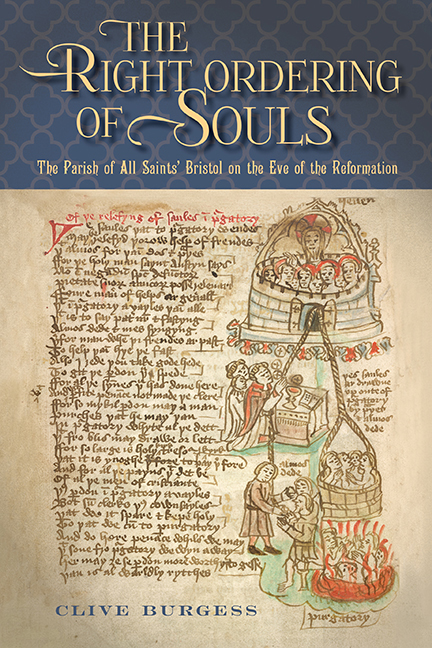Book contents
- Frontmatter
- Dedication
- Contents
- List of illustrations
- Acknowledgements
- Miscellaneous Frontmatter
- Abbreviations
- Notes
- map
- Part I For the increase of the divine service
- Part II All Saints’, Bristol, and its parishioners
- Part III Commemorating the dead
- Part IV Leaders and administrators
- Part V Ordering the parish
- 10 ‘Was but single and no thing of beauty’: Enhancing the parish church
- 11 ‘To the laud and the loving of Almighty God’: Increasing divine service in All Saints’
- Conclusion ‘What else, I ask you, is a city than a great monastery?’
- Appendices
- Bibliography
- Glossary
- Index
- Miscellaneous Endmatter
Conclusion ‘What else, I ask you, is a city than a great monastery?’
from Part V - Ordering the parish
Published online by Cambridge University Press: 05 May 2018
- Frontmatter
- Dedication
- Contents
- List of illustrations
- Acknowledgements
- Miscellaneous Frontmatter
- Abbreviations
- Notes
- map
- Part I For the increase of the divine service
- Part II All Saints’, Bristol, and its parishioners
- Part III Commemorating the dead
- Part IV Leaders and administrators
- Part V Ordering the parish
- 10 ‘Was but single and no thing of beauty’: Enhancing the parish church
- 11 ‘To the laud and the loving of Almighty God’: Increasing divine service in All Saints’
- Conclusion ‘What else, I ask you, is a city than a great monastery?’
- Appendices
- Bibliography
- Glossary
- Index
- Miscellaneous Endmatter
Summary
THE pre-Reformation Church rested mainly upon corporations, some regular, others secular. Having enjoyed unrivalled eminence in the High Middle Ages, regular institutions were giving ground to secular foundations which, quite simply, could better satisfy current needs and circumstances. For the time being, monasteries endured and, in most cases, amply fulfilled the purposes for which they had been founded; moreover, in a centre such as Bristol, the friars – late arrivals to the ranks of the regulars – continued to make a valuable pastoral contribution to the town's spiritual armoury. But new foundations tended to be collegiate and, at the same time, existing secular establishments also developed prodigiously. As another relative latecomer, but taking their place in the array of secular institutions, parishes had started out as truncated corporations, served by single priests and depending mainly upon their congregations to achieve any corporate status. By the early sixteenth century, however, many parishes had themselves come to resemble colleges – or, in terms of staffing and their capabilities, had much in common with the minster churches from which they had long ago developed. While the implications of so thoroughgoing a development have hardly been accorded the attention that they deserve, this study has at least attempted to construct a paradigm revealing in detail how one parish was remaking itself. Had more written evidence survived for a greater number of parishes, it seems likely that many aspects of All Saints’ evolution could be judged as reasonably typical. More generally, while the means they employed may have differed, many parishes shared the institutional ambition of remaking themselves.
The century that preceded the Reformation need not, therefore, be regarded as a time of stasis in English devotional life: it witnessed a wide-reaching transformation in the broader reaches of the secular Church, as many parishes developed into corporations. This was unquestionably the case in larger towns: not only did a number of parishioners among most urban congregations normally enjoy reasonably healthy disposable incomes, but wealthy donors were also inclined to largesse since they stood in particular need of the intercessory services best discharged by the surrogate extended family of co-parishioners, in the present and for generations to come.
- Type
- Chapter
- Information
- 'The Right Ordering of Souls'The Parish of All Saints’ Bristol on the Eve of the Reformation, pp. 413 - 424Publisher: Boydell & BrewerPrint publication year: 2018

